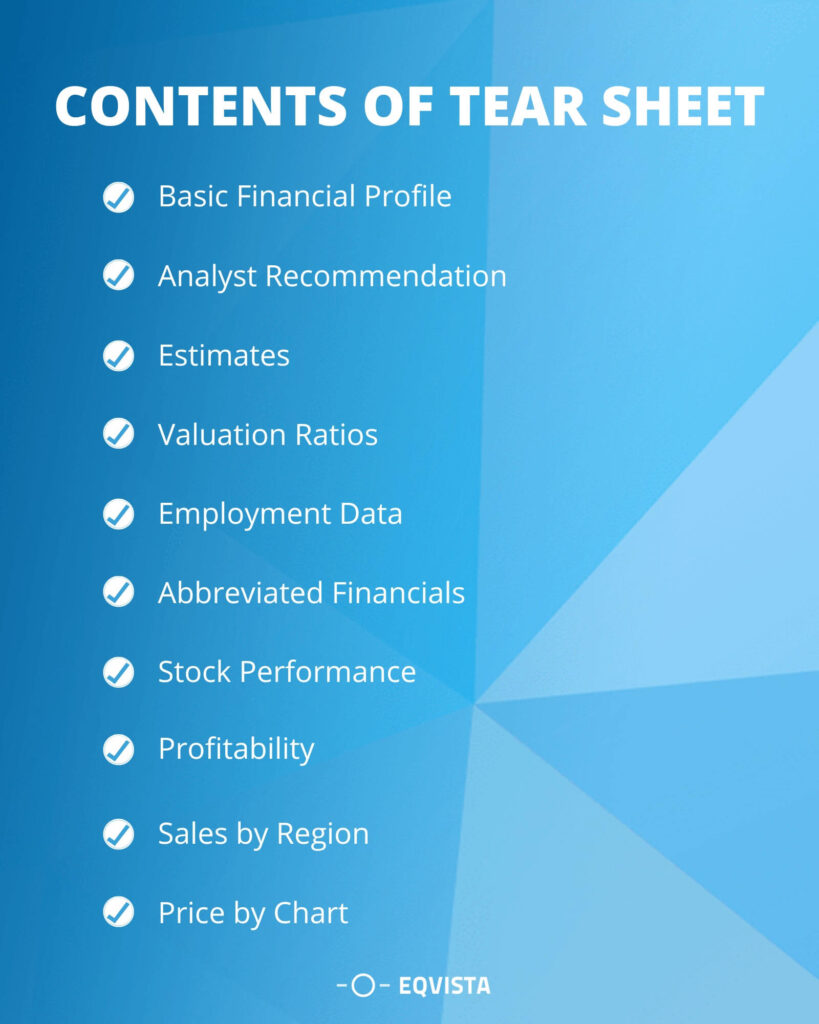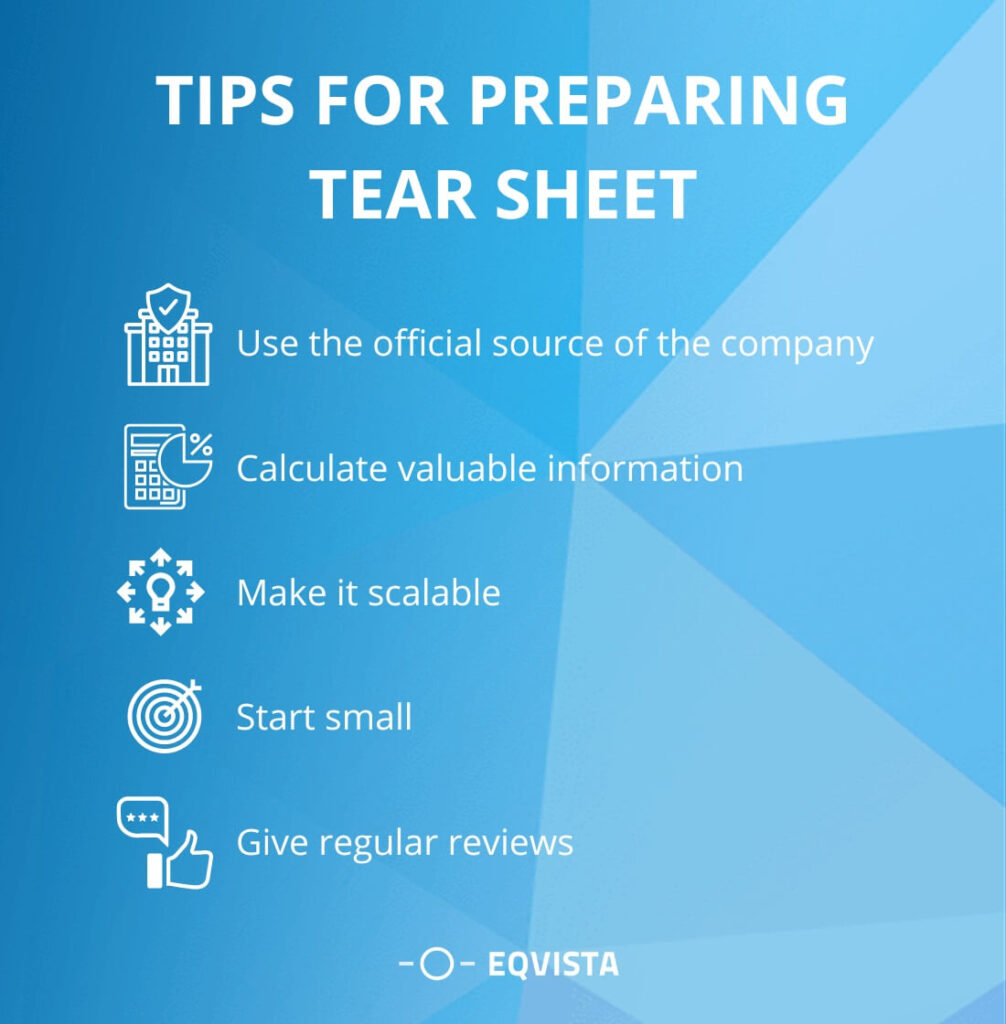What is a Tear Sheet?
The purpose of this article is to provide you with the essential information that you need to know in regard to a tear sheet.
In financial terms, a tear sheet is typically a one-page document that provides essential financial information about a company. This is often used by investors as a quick and easy way to view all the key elements of a company’s financial statements. The term “tear sheet” is actually derived from the fact that it was originally Standard & Poor’s practice to tear the actual financial statements out of its publications and hand them out to clients for their review. You might wonder what is included in a tear sheet and how to prepare one. The purpose of this article is to provide you with the essential information that you need to know in regard to a tear sheet.
Tear sheet overview
The tear sheet is an excellent means of providing a quick overview of your company’s financial details, as well as identifying key elements generally for investment decisions. As a matter of fact, tear sheets may have different uses depending on the industry that you work in. However, in regard to the finance industry, they are an effective means of presenting financial data and highlighting key items. The most common uses of tear sheets include investment justification and due diligence.
What is a tear sheet?
In basic words, a tear sheet is a summary or abstract that contains important information about a company. It is usually a one-page document that provides an overview of fundamental information and provides a brief history of the company. In fact, a tear sheet is also referred to as a fact sheet that aims to improve and explain the meaning of financial data. From market capitalization and earnings to market sector and stock-related details, a tear sheet is an essential part of financial disclosure. Therefore, it gives clarity to the financial information and makes it easier for investors to evaluate a company.
Why use a tear sheet?
A tear sheet is essentially used by the company to provide essential information about its financial activities to investors and equity analysts. In fact, the purpose of a tear sheet is to give an overview of the company’s financials in a concise manner. Here are the top 3 reasons why tear sheets are beneficial to the company and its investors:
- Tear sheet provides a quick snapshot of the company’s key financial numbers, which can be handy when comparing with other industry companies. As a result, it can be used by the company to strategize its future moves, and on the other hand, this can also help investors arrive at a well-informed decision about the company.
- For some companies, a tear sheet is something that helps them to attract investors. For example, if a company is looking to raise capital, a tear sheet can be used as a way to present a special one-page summary of its financial details to potential investors. Likewise, potential investors can gauge the financials of the company based on a tear sheet.
- As a tear sheet is a one-page document, it gives investors and analysts insight into the financials of the company in a matter of minutes. This is certainly a quick and very effective way of understanding a company’s current financial situation and future prospects without digging through the actual financial statements.
Contents of a Tear Sheet
Now that you have a basic idea of what a tear sheet is, it’s time to learn the specifics of what should be included in a tear sheet. Generally, tear sheets are one-page documents that contain essential information about the company and its financial statements. The following is the main content of tear sheet:

- Basic Financial Profile – A tear sheet should include a basic overview of the company’s financial information. The basic information includes market capitalization, the total shares outstanding, enterprise value, stock price, and other related details. Therefore, this is the first part of a tear sheet that you should consider when preparing one.
- Analyst Recommendation – Another important component of a tear sheet is the analyst recommendation. Typically, analysts will conduct research, survey and due diligence on a company before making recommendations. Further, this equity report generated by analysts is used to provide recommendations about buying/selling the company’s shares.
- Estimates – The estimates section of a tear sheet is generally a brief summary of the company’s financial estimates. Sales, earnings per share, EBITDA, and other financial metrics for the current fiscal year are included in this section. Additionally, analyst reports on this matter are included as well.
- Valuation Ratios – Valuation ratios are used to give investors a better understanding of the company’s financial strength and growth potential. The most common valuation ratios used in this section are EV/EBITDA, EV/Revenue, price-to-earning ratio, and price-to-book ratio which are usually based on previous, current, and future projections.
- Employment Data – The employment data section of the tear sheet is generally straightforward and includes the current number of employees, revenue generated per employee, and the growth rate of the company’s workforce. As a result, this section is used as an additional means of evaluating the company’s financial condition.
- Abbreviated Financials – The abbreviated financials section basically consists of a few key pieces of financial information including the balance sheet, income statement, and statement of cash flows. Whether it is sales or gross profit, total assets or total liabilities, operating activities or financing activities, this is where you will find the primary information that you need to evaluate the company.
- Stock Performance – When we talk about stocks, it is important to understand the performance and movements of stocks in the market. This section of the tear sheet provides a snapshot of the company’s stock performance over the period. Typically, the return generated by the company’s stock for different periods is listed.
- Profitability – The profitability section of the tear sheet includes key performance indicators used to determine a company’s financial strength. These indicators may include net income, gross profit, or return on equity. Generally, with a 5-year average of the financial statements, this section provides a comprehensive analysis of the company’s profitability.
- Sales by Region – The sales by region section of the tear sheet provides a thorough insight into how the company’s sales performance has shifted over the period. This section lists the year-on-year and relative changes in sales in each region. Hence, it can be used to evaluate the trends in the company’s sales channels and offerings.
- Price by Chart – The price by chart section is actually a graph that provides information about the market performance of the stock over the period using data such as volume and movements. Usually, a period of 2 years and a moving average of 50 and 200 days are used to identify the relative price movements of the stock.
Tear sheet example
In order to better understand what a tear sheet looks like, the following is a screenshot of an example of a tear sheet for ABC Inc.
| Particulars | Information |
|---|---|
| Market Price of the Shares | $300 |
| Face Values of the Shares | $150 |
| No. of Outstanding Shares | 30,000 shares |
| Estimation of Shares to be Issued | 15,000 Shares through the right shares |
| Fund to be Utilized | For construction project which guarantees a return of 10% on investment in project |
| Price Earning Ratio (Past Year) | 17% |
| Estimated Price Earning Ratio | 20% |
| Future Plans | Amalgamation with ABC Inc. which involves the cost of $5,000 and estimates double the present income |
| Analyst Recommendation | The company is growing at a very fast rate and investment will bear fruitful results |
How to prepare a tear sheet
Now that you know what a tear sheet is, its uses, and its components, let us go over the process of how to prepare a tear sheet. Well, creating a tear sheet is not a difficult process, but it may take some time and effort. That said, with proper research, analysis, and preparation, a tear sheet can be created in a short period of time. Simply gather the required information and compile it in a single document to create a tear sheet. But, what are the tips for preparing a tear sheet?
Tips for preparing tear sheet
The following are some key tips that may help you when preparing a tear sheet:

- Use the official source of the company – Remember, a tear sheet is only valuable if it is prepared using accurate and authentic information. This is why the most important tip for creating a tear sheet is to use the official source of the company. It is recommended to use the company’s financial documents to ensure that the information used is reliable.
- Calculate valuable information – The next tip for creating a tear sheet is to compute the right information before creating your document. In this case, the preparer must identify and research the valuable information that needs to be included in the document from the perspective of an investor.
- Make it scalable – The tear sheet must be easy to read and scalable. This means that the information provided in the tear sheet must be structured in such a way that it can be easily modified or altered with the addition of new information. As such, it will save time and effort in preparing your document.
- Start small – One of the main tips in creating a tear sheet is to start small. More specifically, it is recommended to start with small information and observations. Don’t try to include every piece of information in your document at once. Instead, start with the most important information and observations first.
- Give regular reviews – Lastly, the tear sheet must be continually reviewed, revised, and updated to maintain it up to date. In this regard, feedback, suggestions, and recommendations from credible sources are essential to help you improve your tear sheet. To ensure that the content is accurate and authentic, take the time to review feedback from reliable sources.
Need a cap table management solution? Eqvista can help!
Probably the most useful tool for managing the equity of your company is a cap table. While preparing a tear sheet, a cap table can be used as a reference tool to collect information to evaluate the current equity structure of a company. Why not use cap table management software to manage and track your company’s cap table? Eqvista provides a comprehensive, integrated platform for managing and tracking all the changes in the equity of your company with real-time reports. With Eqvista, you can track and manage the equity of your company from a single platform. Try Eqvista today and manage your company’s cap table in minutes!
Interested in issuing & managing shares?
If you want to start issuing and managing shares, Try out our Eqvista App, it is free and all online!
